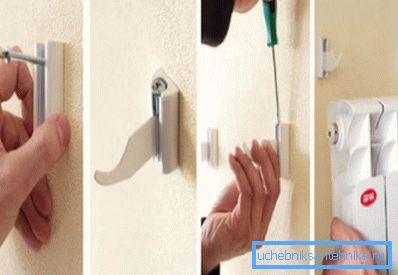Mounts for heating radiators: features of choice and
In this article we will talk about what constitutes a bracket for a heating radiator, how to choose it according to the type of heating system and how to use it for its intended purpose.
The topic of the article is becoming increasingly relevant every year, as an increasing number of heating devices appear on the market, the installation of which requires the use of appropriate fixtures.

Main varieties
So, what kind of fasteners for radiators are on the market, and what to choose from this range? To date, the fastening of the heating radiator is represented by varieties for wall and floor installation.

Important: Special mounting hardware, provided the right choice, can ensure the durability and reliability of the installation of heating batteries. However, the choice of these accessories is largely determined not only by the type of equipment installed, but also by the condition of the walls on which the installation will be carried out.
Wall fasteners are selected in accordance with such characteristics of heating equipment as sizes, weight and configuration.
Therefore, these accessories should be selected according to the type of battery used.
- The brackets for cast iron radiators are represented by the following modifications:
- adjustable steel products - allowing to adjust the gap between the battery and the wall, as well as to align the structure in height in order to achieve a horizontal position;
- cast iron products, designed for substantial mechanical loads;
- steel pin accessories (length no more than 30 cm) - designed for installation work on dense stable surfaces;
- mounts for steel radiators, mounted on a metal strip.
Selecting accessories for mounting cast iron batteries, you need to remember that the weight of these products is great, and therefore the fasteners will have a significant load. Therefore, this load will be transferred to the walls.
As a result, the installation instruction assumes the obligatory preliminary assessment of the state of the wall surface, its strength and tendency to destruction. If the installation of cast-iron structures is performed on insufficiently strong surfaces, the probability of collapse is high. In this case, wall mounts should be supplemented with accessories designed for installation on the floor.
- Fasteners for bimetallic batteries are comparable in degree to their counterparts designed for the installation of cast iron radiators.
Despite the fact that bimetallic structures weigh less than pig-iron analogs, you should not underestimate the load on the surface of the walls. Therefore, it is better to use special brackets or the previously listed versions of fasteners designed for a greater load than to use accessories designed only for a small weight of aluminum batteries.
When choosing durable products for installation work, you need to make sure that these devices fit the bimetallic structure.
- Installation of aluminum batteries can be performed on almost all surfaces and on various types of fasteners.
Due to the low weight during installation, you can limit the wall fixation and dispense with the use of floor fasteners. This is an important advantage, since due to the use of less expensive fasteners, the cost of installation is reduced.

The following types of fasteners are used to install aluminum batteries:
- corner accessories made of steel (standard for aluminum, and reinforced for bimetallic structures);
- pin steel brackets attached by dowels of the required length (usually not less than 120 mm);
- universal wall accessories made of steel with plastic lining.
Important: Some manufacturers for the installation of certain models of batteries manufactured special fasteners.
Floor mounts

At the moment, floor mounting for radiators is used less frequently than wall counterparts are used.
The main reasons for the use of floor mounts is the heavy weight of the radiator or the implementation of design solutions in interior design. By installing a battery with floor support, you can be completely sure that the wall bracket will not collapse, since all the load will fall on the floor.
Today, modern cast iron batteries equipped with standard legs are on the market. Such structures, according to the manufacturer, do not imply the need for attachments. But you need to understand that if the house has a wooden floor on the logs, in order to reduce the load, it is advisable to use wall brackets.
Floor mounting for installation of radiators are represented by the following varieties:
- combined brackets;
- fixed accessories with plastic overlay;
- adjustable jigs with plastic lining;
- Special brackets for 80 and 100 mm wide batteries.
Recommendations for the installation of fasteners

It is easy to install batteries on the brackets with your own hands, the main thing is to carry with you all the necessary tools and approach the implementation of the task as seriously as possible. Since almost all fasteners are fixed on the wall by means of screws, for installation, you will need an electric drill or perforator and drill bits of the desired size, selected according to the type of walls.

If the wall is concrete, we work with a perforator. Drill or drill use the same diameter as purchased for the installation of dowels.
Drilling a hole, we carry the drill smoothly, without tilting it from side to side, so as not to smash the walls of the hole and not to make it wider than necessary. Given the considerable weight of the batteries, you need to install them together.
Conclusion
Now that we know how, and with what accessories, the radiators are mounted to the wall, we can buy suitable tools and get to work. Despite the fact that the price of some mounting kits may seem high, savings in quality of installation is inappropriate.
Do you have any questions that need an exhaustive answer? More useful information you can find by watching the video in this article.